American Treasure: Chaco Canyon
Words: Bronzella Cleveland
Words & Photos: Indi Blake
Nestled at the bottom of a windswept canyon in one of the most remote places in the USA rest the ruins of a once-great civilization. The canyon and its ruins are surrounded by miles and miles of vast open xeric shrubland, home only to a handful of hardy species that can endure the harsh environment here. Most of them are grasses, but a few animals such as prairie dogs, rattlesnakes, and coyotes manage to carve out an existence here (Figure 1). Temperatures can reach over 100 degrees F in the summer and below -30 degrees F in the winter.

Precipitation averages a paltry 8.7 inches per year. Seemingly out of place in what seems like an intolerably inhospitable environment, the ruins suggest a prosperous fertile culture and opulent lifestyle. A place where people must have once flourished, unaware that nearly 1000 years later the debris from their once sophisticated world would be juxtaposed against a seemingly lifeless desert.
Most people are surprised to hear that until the 19th century, the biggest buildings in the United States of America were not factories in Chicago or early high-rises in New York but were a collection of ruins long since abandoned in an arid corner of northwestern New Mexico. Now recognized as a UNESCO world heritage site, the masonry remnants of the Chaco Canyon civilization remain one of the most important cultural centers in America and are North America's largest collection of ancient structures north of Mexico.
The structures were built here over 900 years ago with many dating as far back as 1150 years. Their creators were the ancestral Puebloans, a people whose culture extended far across the southwest spanning the extent of the Colorado Plateau from Colorado and Utah to New Mexico and Arizona. The Puebloans are known for their style of masonry building with slabs of sandstone stacked with mud mortar, usually in the mouths of caves or under rock overhangs.
Their way of life depended on agriculture and established settlements rather than nomadic or raiding strategies employed by other Native American cultures at the time. The ancestral Puebloans’ ambitious building ventures are a testament to just how successful the golden age of Puebloan life was. Their success culminated in the creation of the epic great houses of Chaco Canyon.
Great houses are what archaeologists have come to call the sprawling structures created by the ancestral Puebloans, some containing many hundreds of rooms. Each different in design, many great houses contain underground round rooms called kivas and second and even third story rooms complete with ladders and tunnels. Some great houses were truly immense. The largest great house, Pueblo Bonito spans an impressive 2 acres (Figure 2).

Chaco Canyon’s dense cluster contains 15 such houses and the surrounding areas beyond the canyon contain approximately 150 (Figure 3). Because new structures in Chaco Canyon were built every few decades or so with some taking decades or even centuries to complete, we can get a glimpse into how masonry techniques evolved and progressively got better during the roughly 300 years it took for the great houses to be constructed. Imagine the vast bounty of knowledge acquired by the Chacoan builders painstakingly gathered from 300 years of experience in successes and failures passed down from generation to generation. Even if we know very little about the details surrounding their hopes and fears, we can observe the Chacoan architecture and obtain some insight into the experience of a Chacoan mason.

All structures in the canyon utilized large slabs of stone from the massive Mesa Verde Sandstone Formation situated behind the site. When broken, typically from annual freeze-thaw cycles, the sandstone cleaves into convenient flat sheets. Hundreds of thousands of these sandstone slabs were used in the construction of Chaco’s great houses. When construction began around 800 AD, walls were thin and stacked in irregular orientations that relied heavily on liberal amounts of mortar made from mud (Figure 4).

As the masons attempted more complex architecture, their style began to change. Walls that were built only one stone thick were too unstable when stacked too high. Masons began building their walls thicker and tapered them to be thinner near the top. They soon were able to erect two-story buildings. By 1000 AD they had perfected the wide wall foundations by filling the cores with rubble making walls regularly reach three feet thick. The outer stones were carefully selected to be flat so that when stacked, the sides of the walls looked neat and smooth. (Figure 5).

Timbers were carefully embedded in the walls making second and even third story floors stable. Advanced techniques like pre-planning geometric room shapes and matching outer rocks to have nearly the exact angle needed to create a seamless effect from the inside of rooms were perfected. (Figure 6). Having mastered the structural masonry techniques needed to build massive great houses, masons began employing more intricate and decorative styles. Perhaps because of its satisfying visual effect without sacrificing structural integrity, the McElmo style of masonry began to emerge in the early 1100’s AD. (Figure 7)
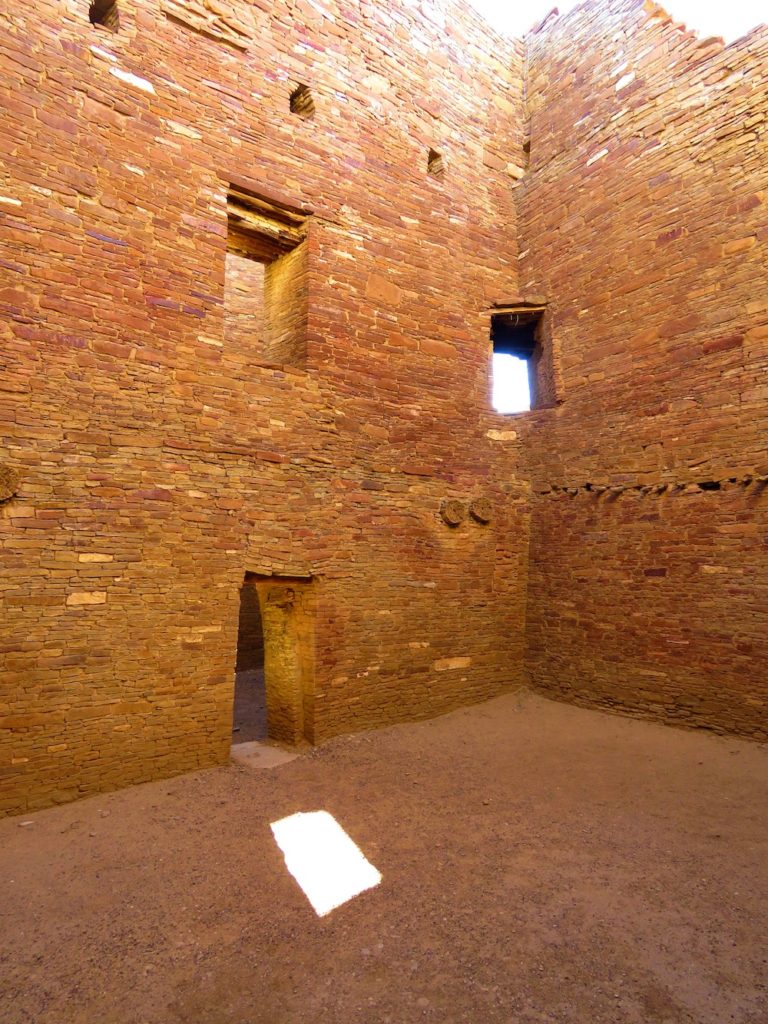
While most of the rooms constructed here are rectangular, there are examples of more eccentric designs. Kivas are round rooms that are set underground and usually covered at the top with only a small opening and a ladder protruding from the top at ground level. While kivas are common among the ruins of the southwest, their concentration in Chaco Canyon is astounding.

There is roughly one kiva for every 29 rooms. To build a kiva, workers would first need to dig a large circular hole usually 5 to 20 feet in diameter around 8 feet deep through some kivas at Chaco such as Casa Rinconada reached a colossal 64 feet in diameter (Figure 8). When stacking rocks to build up the sides, laborers needed to consider the forces working to collapse the walls from the pressure of the earth on the other side, especially during floods.

Only by making the kiva walls thick and interlocking stones for maximum strength could they hope to hold up during floods. Many of the architectural characteristics common in Chaco are unique to the site. T-shaped doorways for example, while ubiquitous in Chaco, haven't been observed anywhere else (Figure 9). It is unclear what the significance of these distinctive features is, though it is tempting to suspect that the site's builders were expressing their artistic preferences similar to Gothic or Victorian architectural styles.
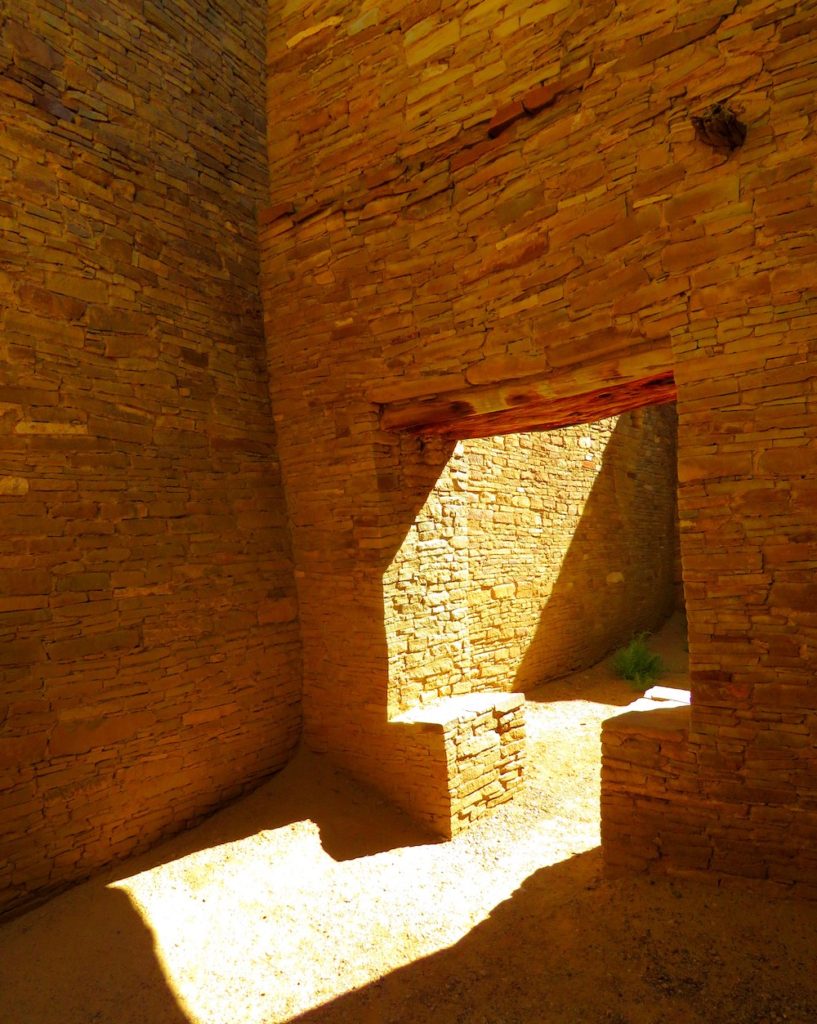
For all their grandeur and obvious cultural significance, archaeologists are unsure as to the exact purpose of the great houses. Analysis of the interiors suggests that most rooms were not inhabited. Little more than mere hints of fire, flood, or waste, the telltale indicators of human habitation, have been found in the great houses. It is thought that much like other ancient monuments such as Tikal in Guatemala or the pyramids of Giza in Egypt, the great houses in Chaco Canyon may have been used primarily for religious or cultural significance. Tangible evidence of the mightiness of Chacoan culture for their people to be awestruck at.
Villagers and townsfolk likely lived in less spectacular, less permanent villages nearby and only gathered at the great houses for ceremonies or trade. Also much like the monuments in Egypt and Guatemala, human burials have been excavated deep within the maze of passages. Graves lined with exotic trinkets and colorful stones have made experts ponder as to the identity of these revered figures. Among the most bewildering of the discoveries here are the curious caches of valuable traded goods sealed in many of the storage rooms.
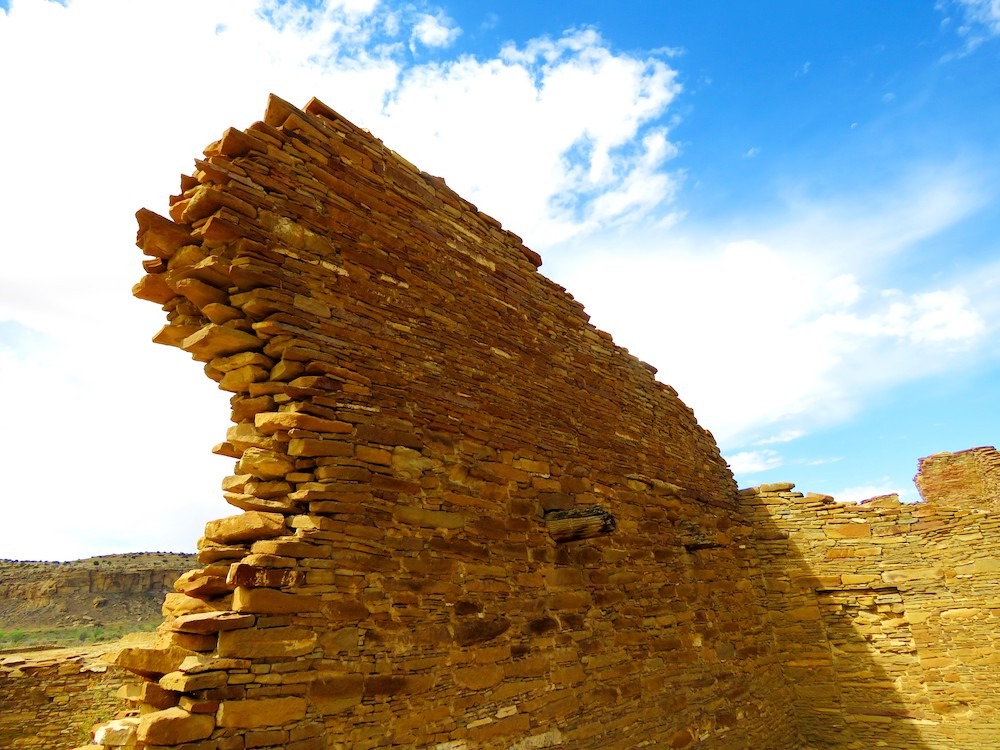
Curious not because of the immense volume of goods, but because of the origins of some of the items. Aside from the over 200,000 pieces of turquoise that have been found along with pots and carved figurines, archaeologists have also found seashells, macaw feathers, and cacao, contradicting the notion that this culture was isolated. Experts now believe that the Chacoans of the southwest United States had contact and traded regularly with Mayan cultures from southern Mexico, a mind-blowing 1500 miles away.
The presence of imports from far-off lands found in Chacoan great houses paints a picture of a bustling society with an appreciation for trade and value placed on objects of beauty. Experts believe that the great houses of Chaco Canyon also served as a central venue for different tribes and cultures to gather and exchange goods and ideas that would otherwise be separated by vast oceans of land. More recent discoveries have exposed over 400 miles of complicated networks of roads extending out from Chaco Canyon.
The roads are not merely worn down footpaths but are elaborate and precise highways up to four lanes wide that necessitated advanced civic planning. Many have their intentional drainage systems to reduce erosion and were constructed so effectively that much of them remain to this day. These revelations lend further evidence to the picture of a society heavily engaged in commerce. Additional discoveries in the canyon reflect the society's knowledge of astronomical phenomena. Many buildings are aligned with the cardinal directions and some are positioned such that sunlight on the equinoxes touches specific points on the rock denoted by pictographs indicating that seasonal change was coming. These astronomical instruments were likely important for Chacoan farmers as the society relied on annual crops for food. Between religious or sacred burials, international trade networks, civic planning, and advanced knowledge of the heavens, Chacoan society has proven to be among the most sophisticated ancient cultures in America.
What brought down this mighty civilization? Evidence of a prolonged 50-year long drought that coincides closely with when people began emigrating from the site reveals the most likely cause. When an entire civilization depends on regular farming cycles, a devastating 5-decade long drought can bring even the most advanced societies to their knees. Unsustainable logging may have contributed to the downfall of the Chacoan society.
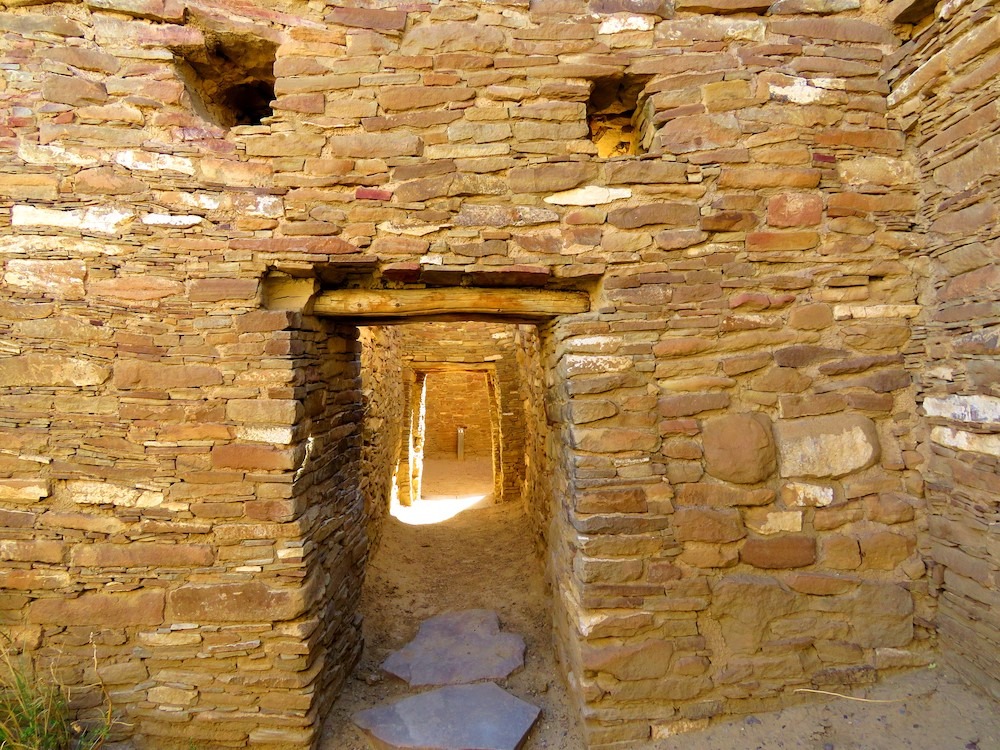
The massive urban building projects in the canyon created an ever-higher demand for timbers. After all the nearby trees had been harvested, workers were forced to haul timbers from over 50 miles away just to keep up with the insatiable need for wood. Between failing crops and lack of usable building materials nearby, the society fell. People in outlying communities began to move away to more prosperous land in 1140 AD and by around 1170 AD the last of the Chacoans had abandoned their once-great city.
The climate remained unstable for the next few hundred years with droughts even more intense than the initial 50-year drought becoming commonplace. This prevented any hope of rekindling the city. In what is now an arid and depleted desert, Chaco’s ruins are the last relic of a bygone era. Amazingly, the Chacoan lineage remains in the American southwest to this day. Both Hopi and Pueblo people trace their ancestry back to the Chacoans. Oral histories have been carefully preserved by being passed down from one generation to the next for almost 1000 years about the legendary golden era of Chaco Canyon.
After centuries of harsh conditions, the structures have held up remarkably well, further proof of the builders’ competence as architects and masons. The first documented exploration of the site by European settlers didn't come until 1823 while the southwest was still a part of Mexico. Because the site was so remote, it was left largely unvisited until 1896 when archaeologists from the Smithsonian began excavation known as the Hyde Exploring Expedition.
The site wasn't fully excavated until the 1920’s when the National Geographic Society conducted a large scale survey and excavation. They removed 100,000 short tons of material from the ruins, largely comprising fallen roofs, toppled walls, and 700 years worth of sand blown in by the wind.
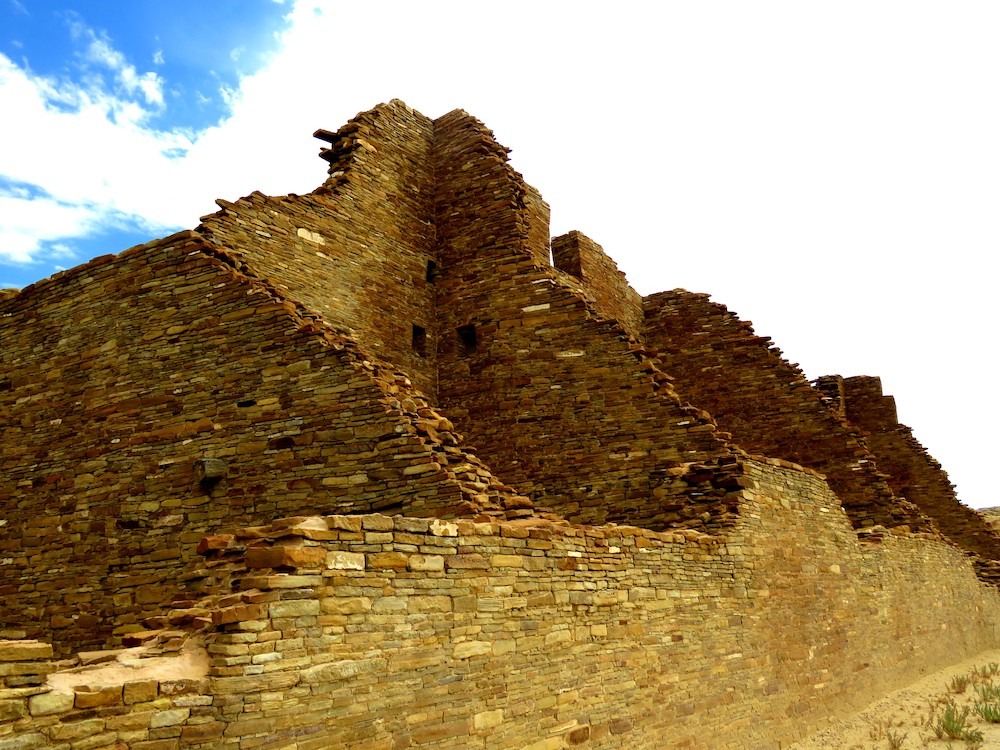
Visitors to the National Historic Park should expect conditions to be somewhat rough but incredibly rewarding. No matter the time of year that you decide to visit, the drastic day/night temperature difference will affect your packing. Most visitors begin their journey from a city nearby. Farmington and Albuquerque are among the closest. From there, expect a 1.5-2.5 hour long drive respectively leading you to a bumpy dirt road that seems to be heading nowhere.
The flat expansive scrubland will suddenly emerge large sandstone towers.
As you get closer, a large canyon will be revealed. If you are lucky enough to get there early, you might be rewarded with a glimpse of the sun’s light creeping up the masonry walls the same way it did nearly 1000 years ago. Most of the 13 great houses in the canyon are open to the public, allowing visitors to walk through the immense structures and get close-up views of the intricate craftsmanship to appreciate the thousands of hours of labor that went into them. Visitors are easily able to put themselves in the shoes of a Chacoan mason visualizing the same engineering challenges the original builders did.
The principles that dictate how best to distribute heavy loads over wooden entryways or how to ensure a wall’s structural integrity by interlocking stones and tapering walls were the same 1150 years ago as they are today. In this way, good masonry transcends all languages and cultures because its specific features can be understood by anyone with an understanding of the craft.
While many of America’s modern masonry wonders are incredible, none have endured for centuries like those in Chaco Canyon have. The ruins left behind in Chaco Canyon make clear that America’s masonry legacy begins far earlier than is usually acknowledged and should be regarded as one of our countries most exalted treasures.